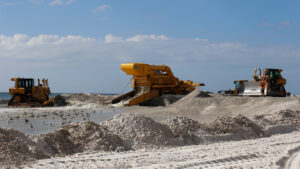This story was originally published by Grist. Sign up for Grist’s weekly newsletter here.
By Jake Bittle, Grist
Lisa Hendrickson is almost out of sand.
Hendrickson is the mayor of Redington Shores, Florida, a well-heeled beach town in Pinellas County. Her town occupies a small section of a razor-thin barrier island that stretches down the western side of the sprawling Tampa Bay metro area, dividing cities like Tampa and St. Petersburg from the Gulf of Mexico. Many of her constituents have an uninterrupted view of the ocean.
The town’s only protection from the Gulf of Mexico’s increasingly erratic storms is a pristine beach that draws millions of tourists every year — but that beach is disappearing fast. A series of storms, culminating in last fall’s Hurricane Idalia, have eroded most of the sand that protects Redington Shores and the towns around it, leaving residents just one big wave away from water overtaking their homes.
This perilous situation is the result of a standoff between local residents and the U.S. Army Corps of Engineers, the federal agency that handles flood prevention and protects many of the nation’s beaches. The Corps often rebuilds eroded beaches by hauling in thousands of tons of sand, but the agency is refusing to deliver $42 million of new sand to Pinellas County unless the area’s coastal property owners grant public access to the slivers of beach behind their homes. Hundreds of these property owners, however, are in turn refusing to sign documents that grant these points of access, which are known as easements. The faceoff has brought the area’s storm recovery to a near standstill.
This standoff highlights growing tensions between the federal government and homeowners in coastal areas that are threatened by climate change. As sea levels have risen and strong storms have caused greater damage than ever before, the costs of protecting and insuring beach fronts in Florida and other states have increased rapidly. Agencies like the Corps have had to weigh these costs against the interests of property owners in places like the Tampa Bay region. When those interests come into conflict, populated coastal areas can be left exposed or uninsured, making them sitting ducks for the next climate-fueled storm.
“Our coastlines are the first line of defense against storms, and our Gulf beaches are just eroding away,” Hendrickson told Grist. “I don’t know where we go with it now, or how we come together to work through it.”

The Corps put the easement policy in place decades ago to ensure that it didn’t spend public money to restore private beaches, but the agency didn’t begin enforcing the rule in earnest until after Superstorm Sandy in 2012. When the Corps tried to replace disintegrated beaches in New Jersey, it discovered that it didn’t have all the easements it needed. Local governments spent years trying to obtain them, and the state government had to use eminent domain to seize portions of the beach in order to satisfy the agency.
In the years since, the agency has warned Pinellas County and other local governments that they won’t get any more sand unless they get easements from all the property owners on their beaches. The Corps says it first raised the issue with Pinellas back in 2017, but tensions started rising last year after Idalia eroded the area’s beaches to a dangerous degree, creating a desperate need for new protective sand.
The Corps requires that easements be “perpetual,” which means that the public will always be able to access the beach area behind an owner’s property. The agency says this is only so that it has the ability to help out after future storms: When a hurricane wipes out a beach, the Corps often swoops in to pay for an emergency beach replenishment just weeks later, ensuring homes don’t wash away. The agency says that it can’t commit to doing this emergency work unless it can be sure that beach access will remain public for good. It also says that it needs easements from all property owners in a given area, because nourishment projects don’t work unless they’re continuous along an entire stretch of sand.
Pinellas County officials tried their best to obtain these easements, even going from door to door and pleading with residents to “sign for sand.” Nevertheless, around half of the 461 property owners along the barrier island have refused to grant them. County officials are still urging residents to submit, but they have obtained few new easements since late last year.
The strange thing about the easement controversy is that these waterfront residents don’t fully own the beaches behind their homes — in fact, most of the county’s beaches are already public. State law provides that all Florida beaches with artificial sand are public up to the “erosion control line,” which is about the same as that which marks high tide. In other words, everything from the water to the high tide line is open for anyone to walk, tan, or spread a blanket. The land in dispute between the Corps and the homeowners is only the section of sand between the backside of a beach house and the high tide line, which in many cases is just a few dozen feet.
“For most of the project, the beach is wide open to the public,” said John Bishop, Pinellas County’s coastal management coordinator. “A lot of the easement areas aren’t even on the beach, they’re in the dune behind the beach.”
Owners’ reasons for refusing easements are numerous, but most cite a fear that granting public access to the sand behind their property will encourage tourists to venture up on their dunes or sit on the sea walls behind their homes. Sure, they can’t stop tourists and beachgoers from using the beach that sits between the erosion line and the water — but they don’t want them coming any closer.
Even those property owners who have granted their easements haven’t yet seen any benefit from doing so, since the Corps won’t deliver sand until everyone complies.

Andrew Youngman, the property manager at the Sea Oats resort condominium in Redington Shores, says the board of his 40-unit building was initially eager to grant the Corps an easement for beach nourishment last year. But when residents learned they wouldn’t get new sand unless the county secured easements from all property owners, they figured it would never happen, so they never finished the paperwork. Since then, Youngman has watched the area around his property erode.
“We’re probably in the best shape in the vicinity, because we have a dune of our own out there,” Youngman told Grist. “Everyone else is just flat from their building to the water.”
The local government and the Army Corps of Engineers have kept up this staring contest for almost a year now, and some political heavyweights have gotten involved on the county’s side. Sens. Rick Scott and Marco Rubio and Rep. Anna Paulina Luna, all Republicans, have accused the Corps of holding up the beach project on bureaucratic grounds. Last month Scott sent a letter to the Corps saying that his constituents “have seen enough inaction.” The letter urged the Corps to relax its easement policy and said that “further delays on these projects could cause catastrophic damage to … coastal communities.”
In response to questions from Grist, a spokesperson for the Corps gave no indication that the agency will budge on its policy, which it has begun to enforce elsewhere in Florida and in other coastal states like South Carolina.
Even when Pinellas County tried to obtain separate temporary easements to build new emergency dunes at the top of its beaches, many residents still refused, in part out of a concern that new dunes would block their ocean views. This further stalemate with homeowners has forced the county to build a piecemeal dune behind coastal properties, leaving holes in front of the homes and hotels where the owners didn’t want to grant an easement.
This broken dune won’t do much come storm season, according to René Flowers, a Pinellas County commissioner who has been pushing the Corps to deliver the sand.
“When you have a break in the chain, then all of the work that you’re doing is not as impactful in protecting as it would be,” she said.
Rob Young, a professor of geology at Western Carolina University and a frequent critic of beach nourishment projects, says Pinellas County should fund the nourishment itself through sales tax increases rather than relying on the federal government to pay for new sand. He pointed out that some beach towns on the Outer Banks of North Carolina have taxed tourism to pay for sand after the federal government stopped covering the costs.
“For a lot of people, the privacy is more important to them than the risk of destruction,” he said, referring to residents who refused to grant easements. “The solution is very easy — pay for your own risk.” Young added that many nourishment projects don’t seem to be worth the money they cost. He pointed to the Jersey Shore, where a $1 million beach nourishment project washed away in just one year.
The knowledge that beach nourishment might not be a good investment doesn’t do much to help local leaders like Flowers, the Pinellas County commissioner, who is bracing herself for a hurricane season that meteorologists predict will be one of the most active in decades.
“I’m very concerned for those homeowners out there who will be impacted because perhaps their neighbor has opted not to allow access,” she said.
This article originally appeared in Grist at https://grist.org/extreme-weather/redington-shores-tampa-florida-beach-erosion-hurricanes/.
Grist is a nonprofit, independent media organization dedicated to telling stories of climate solutions and a just future. Learn more at Grist.org.
Sign up for The Invading Sea newsletter by visiting here. If you are interested in submitting an opinion piece to The Invading Sea, email Editor Nathan Crabbe at ncrabbe@fau.edu.


